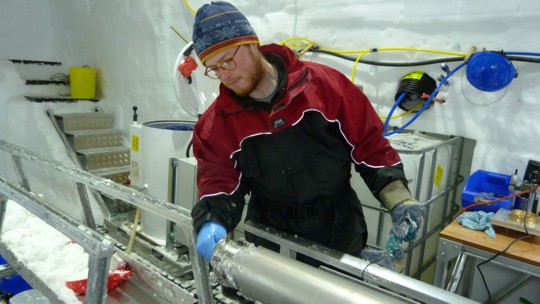Peter Neff
As an undergraduate at the University of Washington in Seattle, Peter Neff took an intro geology course and got really excited. “I hadn't anticipated getting into science, but then I didn't really know what I wanted to do. I liked history and was always interested in basic science, so I guess that was the connection with geology. In that first course, I learned all these great stories about the Earth through studying geology and simply observing geological processes and evidence all over the planet”, explains Peter.
While Peter was working on his Bachelors in geology, he was lucky enough to get hired for a lab technician position that advertised having "potential fieldwork opportunities in Greenland and Antarctica." That was Peter’s start into "cold science," and he hasn’t stopped since.

After finishing his Bachelors and Masters degrees, Peter became aware that the Antarctic Research Centre’s Nancy Bertler, was beginning to drill a new ice core at Roosevelt Island (see RICE project), an ice dome within the Ross Ice Shelf, Antarctica. The site is of great interest for its position within the dynamic ice shelf and the potential to learn about the history of the Ross Ice Shelf through the last ice age to present (about 40,000 years). So Peter moved to New Zealand in 2012 with his partner Heidi Roop, also a PhD student at the Antarctic Research Centre at that time, to begin his PhD at Victoria University of Wellington.
“I was interested in experiencing the research and academic environment in another country, as well as to learn from Nancy and the rest of the Kiwi ice-drilling group.”
Peter spent nearly four months in Antarctica during the 2012-2013 season, drilling the deep ice from 130 m to 765 m at Roosevelt Island. He then spent another two months in the cold laboratory at the New Zealand Ice Core Facility based at GNS Science, cutting ice samples for analysis.
“This was not a trivial process—it involved more than a dozen people from all over the world coming to New Zealand, and spending six days a week for more than two months cutting ice, monitoring lab equipment, keeping workspaces "ultra-clean," and taking samples for later measurements”, explains Peter.
For his PhD, Peter was interested in the recent part of the ice core record (approximately the past 2000 years), with an emphasis on quantitative understanding of the modern processes controlling aerosol transport to and deposition at Roosevelt Island. One of his favourite things about ice cores is that these records extend from the surface snow, which represents today, back many thousands of years in the deepest ice. “This means we can compare snow chemistry with modern, measured climate data, and extend real relationships between the two well into the past.”
Peter measured the rare earth element concentrations in mineral dust contained within the snow and ice, with the intent to establish rare earth element "fingerprints" of the initial source areas where mineral dust particles originate before being blown across the Southern Ocean to Antarctica. “
Peter says “In this way, I'm using the mineral dust chemistry as a "tracer" for atmospheric transport paths from extra-Antarctic locations such as Australia, New Zealand and Argentina to Roosevelt Island, Antarctica.”
Peter and his partner Heidi Roop completed their PhDs in 2015 and the ARC team look forward to continued contact with them as they advance their careers as scientists back in the United States.
